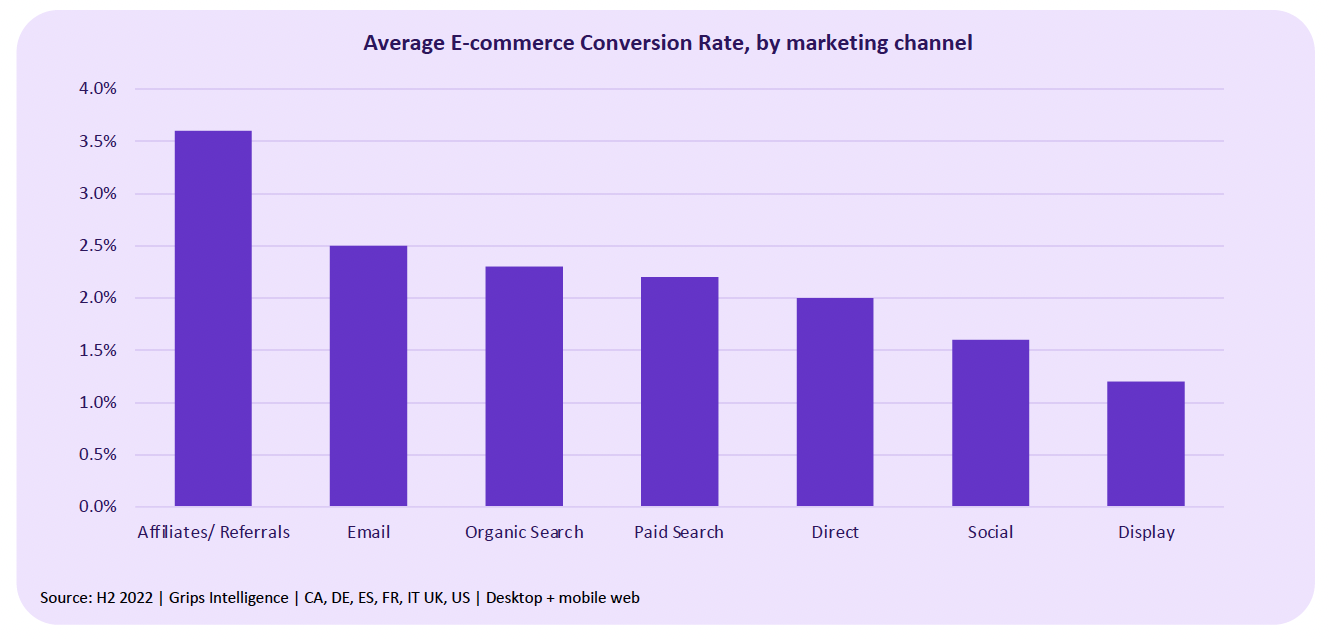One of the most important metrics for measuring the health of an e-commerce business is conversion rate, which refers to the percentage of visits to your website that result in a purchase. The more of your browsers that you can convert to buyers, the more successful your business will be.
While there are an untold number of factors that can impact e-commerce conversion rates, below are five measurable factors that we explore in our 2023 E-commerce Conversion Benchmark Report with data from Grips to quantify the impact.
1. Product Category
The type of product you sell can have a significant impact on your conversion rate. Products that require a high level of trust or carry a high price may require more information or a hands-on experience before customers are convinced to make a purchase. In fact, Jewelry & Luxury Products sites have among the lowest conversion rates, on average, of any retail category reported by Grips. Pet Food & Supplies and Groceries, two everyday categories where a lot of the purchases are repeat items, have the highest conversion rates. Sites specializing in these types of products tend to enjoy higher conversion rates, on average. And while it may be tempting to diversify your assortment by introducing products in different categories, doing so may have an impact on your site’s conversion rate.

2. Average Order Value
Average order value, or AOV, refers to the average amount spent by a customer per purchase. Grips data shows that AOV is inversely related to conversion rate meaning that as AOV goes up, conversion rates go down. Specifically, sites with an AOV below $100 enjoy the highest conversion rates with the Goldilocks Zone being an AOV between $50 and $100. As AOV rises above $250, conversion rates see a sharp decline.

3. Marketing Channels
The digital marketing channels you use to promote your site can significantly influence your conversion rate. Grips found that Referrals and Affiliates drive traffic that is the most likely to convert. Email is another channel that will typically deliver more sales. Meanwhile, Social and Display post lower conversion rates, on average, and when traffic from these channels does convert, it is often at a lower price.

4. Device
Mobile devices now account for the majority of e-commerce activity. According to Grips, over 70 percent of online browser-based shopping sessions occur on mobile devices. But only 59 percent of transactions are completed on mobile. In fact, mobile conversion rates are roughly 50 percent lower than what Grips sees for desktop. This means that not enough retailers and brands are optimizing their mobile site for conversions. While mobile apps tend to get a lot of attention, most consumers will not download and keep an app from a site they don’t interact with regularly, making mobile web the primary channel on which to focus.

5. Country
The country your customers are in can impact conversion rates. Different cultures, languages, and buying habits can all influence how customers interact with your website. Companies that do business around the world will need to benchmark their activity against regional norms instead of expecting all countries to convert at similar rates. For example, our latest report revealed that Germany, the United Kingdom and the United States have among the highest conversion rates. Meanwhile, Italy, Spain, France and Canada convert at lower rates.

Download the full report for free where you can read about five other factors that influence conversion rate as well as learn which sites have the best (and worst) conversion rates in five key retail categories.